TIRR Memorial Hermann is a leader in research and technology to assist in our patient’s rehabilitation. We believe in giving our patients access to the latest technology and medical breakthroughs to provide them with the best care possible. Innovative technology can help speed up the recovery process, while providing physiological and psychological benefits to our patients. Our goal is to get our patients back to the life they love.
ReWalk Exoskeleton
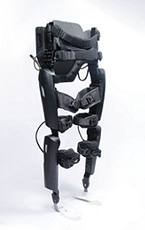
The ReWalk is a gait training technology intended for use by individuals who suffer from various lower-limb disabilities such as stroke, spinal cord injury, traumatic brain injury, paraplegia and more. It allows for controlled, independent walking and mimics the natural gait of an able-bodied individual. The ReWalk has been a game changing rehabilitation device, providing both physical and psychological benefits. The ReWalk not only gives our patients at TIRR Memorial Hermann the ability to exercise and walk around, but also the ability look someone in the eye or give a loved one a hug. These physical and psychological benefits allow for better pain management, fewer medications and potentially reduced hospitalizations.
Nexstim Stroke Case Study
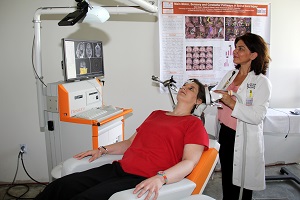
Researchers are able to use a noninvasive device capable of mapping the human brain to deliver targeted magnetic stimulation to the brain that can suppress or enhance specific brain activity. They are then able to determine the therapeutic effects of the navigated magnetic pulses for stroke rehabilitation. Initial results suggest the navigated repetitive transcranial magnetic stimulation coupled with occupational therapy is more likely to promote clinically important improvements in the patient than occupational therapy alone. These early results have opened the door to improving the quality of life for stroke survivors offering hope to thousands of people.
Chief Medical Officer Dr. Gerard Francisco along with Dr. Nuray Yozbatiran, researcher in the UTHealth Neuromodulation and Neural Interfaces Laboratory at TIRR Memorial Hermann’s NeuroRecovery Research Center are facilitating the stroke trial at TIRR Memorial Hermann.
Eksoskeleton
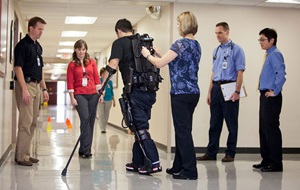
GAITRite Gait Analysis
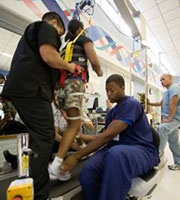
As a patient walks across the walkway, the system inputs data into the computer to document walking patterns, including both step time and step length. This captures abnormal walking patterns persons have adopted to compensate for muscle weakness, pain or limb shortening.
Patients using assistive devices and walking aides such as crutches, walkers or canes, use these during their gait analysis. Therapists can use this data to assist with interventions and treatment designed to improve balance and gait. The data also helps to show progress.
Lokomat® Locomotion Training
Patients with neurological movement disorders are benefiting from intensive robotic rehabilitation therapy at TIRR Memorial Hermann Kirby Glen, using the Lokomat®, the world's first driven gait orthosis.
The Lokomat assists walking movements of gait-impaired patients and is used to improve mobility in individuals following conditions including:
- Stroke
- Spinal cord injury
- Traumatic brain injury (TBI)
- Multiple sclerosis (MS)
- Other neurological diseases and injuries
The Lokomat is the first in Houston and only one of 100 in the entire world. It was provided for use at TIRR Memorial Hermann by a grant from the Medallion Foundation.
Lokomat® Locomotion Therapy for Children
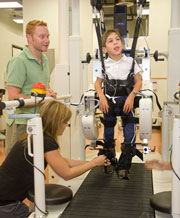
The Broughton Foundation, the Wednesday Charity Club and other individuals donated the funds for this equipment.
The Pediatric Lokomat is the first driven automated gait orthosis for children, which relieves therapists of the manual labor required during manually-assisted treadmill training. Training sessions can be longer, the therapy is more efficient and it can be expected to achieve desired training goals sooner.
With the Pediatric Lokomat patients from approximately four years of age can be trained with the Lokomat if the gait orthosis can be adjusted adequately. The reduced size robotic gait orthosis offers the same benefits as the Lokomat for adults. Special harnesses and cuffs ensure precise fit for small children.
Initial experiences have indicated that children generally enjoy gait training with the Lokomat. If a child requires extra motivation, a cartoon can be played on the patient monitor.